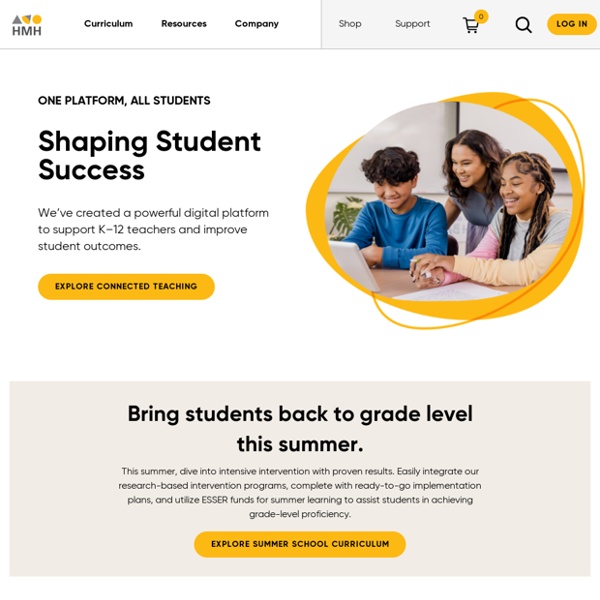



The Common Core Standards Find links to classroom and professional development resources for K–3 teachers, as well as tips and resources to help librarians and parents support the goals of the Common Core. For those who are new to the Common Core, we offer an overview of the standards and how they will shift English Language Arts teaching and learning. Overview of the Common Core The Common Core State Standards (CCSS) are an effort by states to define a common core of knowledge and skills that students should develop in K–12 education so they will graduate from high school prepared for college or careers. The standards were first released in 2010; by the end of 2012 these shared standards have been adopted by 45 states plus the District of Columbia. Visit the official website: Common Core State Standards Initiative
A Non-Freaked Out Approach to Character Strengths and Common Core The Common Core does a pretty good job of laying out some key cognitive skills students need to be ready for career or college. Yes, for you CCSS doubters out there, I said it–I think the standards are good. Granted, I like boiling their goodness down and distilling it into a more potent greatness (if you’re new, refer to the focused, non-freaked out approach we talk about here in the Teaching the Core community). But here’s the bold claim I’ll spend this post backing up: if you aim at the Common Core goals only by doing increased text complexity, close reading, arguing, mandatory talking, and writing like crazy, you or a large amount of your students will begin to hate your/their life. Before you throw your computer in frustration, hear me out.
Skills Overview The Big6™ Developed by Mike Eisenberg and Bob Berkowitz, the Big6 is the most widely known and widely used approach to teaching information and technology skills in the world. Used in thousands of K-12 schools, higher education institutions, and corporate and adult training programs, the Big6 information problem-solving model is applicable whenever people need and use information. The Big6 integrates information search and use skills along with technology tools in a systematic process to find, use, apply, and evaluate information for specific needs and tasks. Why Big6™?
Children's Sun Signs Your Child's Sun Sign Your Aries Child Aries is a Fire sign on the action cross. Its symbol is The Ram (she bucks!) Your little firecracker is apt to go for it! Being an Effective Tutor Step One: Know what is Expected of You as a Tutor Tutoring is the process of getting students to become independent through questioning. Tutoring should help students develop self-confidence and improve study skills. In addition, the tutoring session should provide students with an opportunity to speak up and ask questions, an opportunity sometimes unavailable or missed in a regular classroom situation. Tutoring is a well-balanced question/information exchange in which both parties participate and, therefore, both benefit. Tutoring provides the practice and drill in specific course material needed by the student, while giving the tutor valuable review opportunities and the chance to develop and sharpen educational and communication skills.
3 Ways to Improve Your Student Engagement with "Discussions" - Skillshare Blog Developing an engaged student following on Skillshare is one of the most important elements of becoming a successful teacher, and Discussions makes it easier than ever to keep your followers in the know. You can turn to Discussions to announce a new class, share a relevant resource or website, or just to let your followers know what you’re up to. Remember, the more your followers feel connected to you and your brand, the more likely they'll be to enroll in your future classes. We’ve rounded up a few great ways to use the feature: Post a New Class Announcement How to Make a Lesson Plan (with Sample Lesson Plans) Steps Method 1 of 3: Creating the Basic Structure <img alt="Make a Lesson Plan Step 1 Version 2.jpg" src=" width="670" height="503" id="553e37528961d">1Know your objective. At the beginning of every lesson, write your lesson plan goal at the top.
Teaching Teaching in the area of art, culture, conservation and heritage is important in different faculties of Maastricht University and cross-faculty cooperation takes place in various forms and levels (Bachelor, Master, PhD). An example is the successful joint Minor of the Faculty of Arts and Social Sciences and the Faculty of Law named “Art, Law and Policy Making”. Besides diverse honours programs, Maastricht University offers the Master Arts and Heritage: Policy, Management and Education as well as several BA level courses on, for example, law and art, the art market, art theory, and museum studies. Since two years the Science Programme at Maastricht University offers a course on ‘Science and the Visual Arts: Conservation and its Histories’ developed by the Faculty of Arts and Social Sciences and Stichting Restauratie Atelier Limburg.
Preservation Underground - Duke University Libraries Preservation As evidenced by the archives from the tag “Boxing Day“, we make a lot of boxes in the lab. Some objects require specific enclosures and we have many materials and techniques at our disposal for fulfilling the needs of the object. Of particular interest to me lately have been enclosures appropriate for parchment over boards bindings, which include some form of restraint. Parchment is hygroscopic by nature and will change size and shape dramatically under different environmental conditions (Woods, 2006).
ECPN Webinar: Pathways into Conservation Science The Emerging Conservation Professionals Network (ECPN) is pleased to announce that our next webinar “Pathways into Conservation Science” will take place on Friday, April 22nd from 12-1pm (EST). Description The program will feature three speakers: Dr. Tom Learner, Head of Science at the Getty Conservation Institute; Dr. Gregory Smith, the Otto N. Frenzel III Senior Conservation Scientist at the Indianapolis Museum of Art; and Dr.